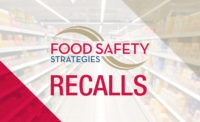Evaluating the real costs of a food product recall

July was a tough month for a few manufacturers of baked snacks thanks to product recalls—the result of possible bacterial contamination.
Pepperidge Farm was notified by one of its ingredient suppliers that whey powder in a seasoning applied to four varieties of crackers was the subject of a recall by the manufacturer. The reason? Potential presence of Salmonella. Pepperidge Farm initiated an investigation and, out of abundance of caution, voluntarily recalled the varieties, which had been distributed throughout the U.S. No illnesses were reported, but consumers who purchased any of the products in question were urged to discard them without eating or return them to the point of sale. One variety of the crackers was similarly recalled voluntarily by Campbell Company of Canada, triggered by the U.S. recall.
Mondelez initiated a voluntary recall in the U.S., Puerto Rico and the U.S. Virgin, pulling certain varieties of crackers from store shelves and snack displays. Canada likewise followed suit and recalled the crackers. Like the Pepperidge Farm recall, the Mondelez products contained whey powder, which the supplier had recalled due to possible Salmonella contamination.
Whey powder, once again, was the cause of a Flowers Foods recall of its Swiss rolls, including under several private labels, distributed nationwide. Flowers also recalled one of its regional bread brands due to the potential presence of Salmonella in the whey powder.
In these recalls, all due to the presence of potentially tainted whey powder, the manufacturers discovered that the recalls did not stem from some sort of food safety or sanitation issue in their own bakeries, but rather could be traced to a third party—and particularly that nobody has reported any illness associated with the products to date.
And then they can breathe a sigh of relief.
Or can they? Do consumers who read or hear “recall” or “Salmonella” in relation to a popular brand really care which ingredient is the culprit and where it originated?
The negative impact to a manufacturer in the aftermath of a food-product recall can be huge and multifaceted. According to the “Capturing Recall Costs” report from the Grocery Manufacturers Association:
- 81 percent of member respondents characterized the range of financial risk of a recall as “significant” to “catastrophic”
- 77 percent estimated the cost of recalls at up to $30 million, with 23 percent reporting even higher estimated costs
- The largest recall costs came from interruption of the company’s day-to-day business and product disposal
Not only is the company liable for the costs of the recovery operations, it must also address damage to its brand and image. To the consumer, a recall instantly suggests something’s wrong. As a result, it can lead to long-term injury to a hard-fought reputation, not to mention market share.
When it comes to financial implications, there are several key steps a company can take to help prepare for a recall.
Recovery preparedness. Every food manufacturer should have a recovery team that includes representatives from legal, operations, customer service and corporate communications departments. Create a plan, including recovery goals, and write it down. This plan should include the company’s legal responsibilities, risk tolerance and decision-making structure. This will help ensure that everyone is in accord regarding required steps before a recall occurs. Have the finished plan reviewed by legal and regulatory experts.
Forecast the financials. Manufacturers need to create detailed estimates of potential expenditures and losses that could potentially occur during every stage of a possible recall. Then, team members can list the potential scope of those losses and determine how to address, or even mitigate, those expenditures in the event of a recall.
Establish digital recordkeeping. Every food manufacturer should establish and maintain a strong enterprise resource planning (ERP) system, including integrated technology and software, that includes recordkeeping details for all company brands, ingredients, order and lot numbers, packaging details, customers, distribution schedules and established shelf life determinations.
In the case of product recalls, the best offense is often a great defense.
Looking for a reprint of this article?
From high-res PDFs to custom plaques, order your copy today!



